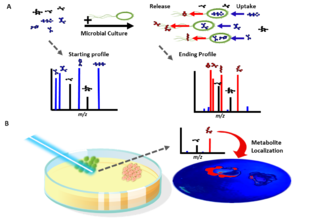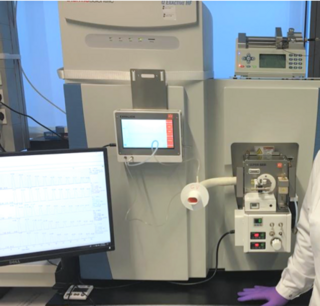Related Research Articles
In biochemistry, a metabolite is an intermediate or end product of metabolism. The term is usually used for small molecules. Metabolites have various functions, including fuel, structure, signaling, stimulatory and inhibitory effects on enzymes, catalytic activity of their own, defense, and interactions with other organisms.

Pentane is an organic compound with the formula C5H12—that is, an alkane with five carbon atoms. The term may refer to any of three structural isomers, or to a mixture of them: in the IUPAC nomenclature, however, pentane means exclusively the n-pentane isomer; the other two are called isopentane (methylbutane) and neopentane (dimethylpropane). Cyclopentane is not an isomer of pentane because it has only 10 hydrogen atoms where pentane has 12.
Volatile organic compounds (VOCs) are organic compounds that have a high vapor pressure at room temperature. High vapor pressure correlates with a low boiling point, which relates to the number of the sample's molecules in the surrounding air, a trait known as volatility.

Metabolomics is the scientific study of chemical processes involving metabolites, the small molecule substrates, intermediates, and products of cell metabolism. Specifically, metabolomics is the "systematic study of the unique chemical fingerprints that specific cellular processes leave behind", the study of their small-molecule metabolite profiles. The metabolome represents the complete set of metabolites in a biological cell, tissue, organ, or organism, which are the end products of cellular processes. Messenger RNA (mRNA), gene expression data, and proteomic analyses reveal the set of gene products being produced in the cell, data that represents one aspect of cellular function. Conversely, metabolic profiling can give an instantaneous snapshot of the physiology of that cell, and thus, metabolomics provides a direct "functional readout of the physiological state" of an organism. There are indeed quantifiable correlations between the metabolome and the other cellular ensembles, which can be used to predict metabolite abundances in biological samples from, for example mRNA abundances. One of the ultimate challenges of systems biology is to integrate metabolomics with all other -omics information to provide a better understanding of cellular biology.

The metabolome refers to the complete set of small-molecule chemicals found within a biological sample. The biological sample can be a cell, a cellular organelle, an organ, a tissue, a tissue extract, a biofluid or an entire organism. The small molecule chemicals found in a given metabolome may include both endogenous metabolites that are naturally produced by an organism as well as exogenous chemicals that are not naturally produced by an organism.
Dimethyl sulfide (DMS) or methylthiomethane is an organosulfur compound with the formula (CH3)2S. The simplest thioether, it is a flammable liquid that boils at 37 °C (99 °F) and has a characteristic disagreeable odor. It is a component of the smell produced from cooking of certain vegetables, notably maize, cabbage, beetroot, and seafoods. It is also an indication of bacterial contamination in malt production and brewing. It is a breakdown product of dimethylsulfoniopropionate (DMSP), and is also produced by the bacterial metabolism of methanethiol.

An electronic nose is an electronic sensing device intended to detect odors or flavors. The expression "electronic sensing" refers to the capability of reproducing human senses using sensor arrays and pattern recognition systems.
Exhaled breath analysis is a method in medicine for gaining information on the clinical state of an individual by monitoring the components present in the exhaled breath.

Breathing is the process of moving air into and from the lungs to facilitate gas exchange with the internal environment, mostly to flush out carbon dioxide and bring in oxygen.
Anton Amann was an Austrian chemist and Professor of chemistry at the Innsbruck Medical University. He worked in the area of physical chemistry, ECG analysis, and exhaled breath analysis.
Breath diagnostics involves the analysis of a sample of human breath to monitor, diagnose, and detect diseases and conditions. Besides its primary constituents – nitrogen, oxygen, carbon dioxide and water vapour – exhaled human breath contains over one thousand other compounds at trace levels. Many of these species are formed as the by-products of metabolic processes and can be indicative of a number of different diseases and conditions. Examples of such biomarkers are outlined below:
Breath gas analysis is a method for gaining information on the clinical state of an individual by monitoring volatile organic compounds (VOCs) present in the exhaled breath. Exhaled breath is naturally produced by the human body through expiration and therefore can be collected in non-invasively and in an unlimited way. VOCs in exhaled breath can represent biomarkers for certain pathologies. Breath gas concentration can then be related to blood concentrations via mathematical modeling as for example in blood alcohol testing. There are various techniques that can be employed to collect and analyze exhaled breath. Research on exhaled breath started many years ago, there is currently limited clinical application of it for disease diagnosis. However, this might change in the near future as currently large implementation studies are starting globally.

The Golm Metabolome Database (GMD) is a gas chromatography (GC) – mass spectrometry (MS) reference library dedicated to metabolite profiling experiments and comprises mass spectral and retention index (RI) information for non-annotated mass spectral tags together with data of a multitude of already identified metabolites and reference substances. The GMD is hosted at the Max Planck Institute of Molecular Plant Physiology in Golm district of Potsdam, Germany.
Metascreen is an advanced non-invasive metabolic screening test distributed by Cordlife Group Limited ("Cordlife"). It can detect as many as 110 inborn errors of metabolism from a urine specimen. Cordlife owns the brand name and trademark, "Metascreen".

Hossam Haick is an Arab-Israeli scientist and engineer, and the current dean of undergraduate studies at the Israel Institute of Technology. He is a pioneer known for inventing the Nano Artificial Nose (NA-NOSE) for detection of disease from exhaled breath, by which he was highlighted as MIT's Innovators under 35; and which is widely used for sniffing out diseases' biomarkers in labs and industries. He has many contributions in multidisciplinary fields such as Nanotechnology, Nanosensors,, Volatile Biomarkers, and Molecular Electronics.
Volatolomics is a branch of chemistry that studies volatile organic compounds (VOCs) emitted by a biological system, under specific experimental conditions.

Exometabolomics, also known as 'metabolic footprinting', is the study of extracellular metabolites and is a sub-field of metabolomics.

Secondary electro-spray ionization (SESI) is an ambient ionization technique for the analysis of trace concentrations of vapors, where a nano-electrospray produces charging agents that collide with the analyte molecules directly in gas-phase. In the subsequent reaction, the charge is transferred and vapors get ionized, most molecules get protonated and deprotonated. SESI works in combination with mass spectrometry or ion-mobility spectrometry.
Gas chromatography-olfactometry (GC-O) is a technique that integrates the separation of volatile compounds using a gas chromatograph with the detection of odour using an olfactometer. It was first invented and applied in 1964 by Fuller and co-workers. While GC separates volatile compounds from an extract, human olfaction detects the odour activity of each eluting compound. In this olfactometric detection, a human assessor may qualitatively determine whether a compound has odour activity or describe the odour perceived, or quantitatively evaluate the intensity of the odour or the duration of the odour activity. The olfactometric detection of compounds allows the assessment of the relationship between a quantified substance and the human perception of its odour, without instrumental detection limits present in other kinds of detectors. Compound identification still requires use of other detectors, such as mass spectrometry, with analytical standards.
Smell as evidence of disease has been long used, dating back to Hippocrates around 400 years BCE. It is still employed with a focus on volatile organic compounds (VOCs) found in body odor. VOCs are carbon-based molecular groups having a low molecular weight, secreted during cells’ metabolic processes. Their profiles may be altered by diseases such as cancer, metabolic disorders, genetic disorders, infections, and among others. Abnormal changes in VOC composition can be identified through equipment such as gas chromatography-mass spectrometry(GC-MS), electronic nose (e-noses), and trained non-human olfaction.
References
- ↑ Broza, Yoav Y.; Mochalski, Pawel; Ruzsanyi, Vera; Amann, Anton; Haick, Hossam (Sep 2015). "Hybrid volatolomics and disease detection". Angew Chem Int Ed Engl. 54 (38): 11036–48. doi:10.1002/anie.201500153. PMID 26235374.
- ↑ Phillips, Michael; Cataneo, Renee N.; Chaturvedi, Anirudh; Kaplan, Peter D.; Libardoni, Mark; Mundada, Mayur; Patel, Urvish; Zhang, Xiang (2013-09-25). "Detection of an Extended Human Volatome with Comprehensive Two-Dimensional Gas Chromatography Time-of-Flight Mass Spectrometry". PLOS ONE. 8 (9): e75274. Bibcode:2013PLoSO...875274P. doi: 10.1371/journal.pone.0075274 . ISSN 1932-6203. PMC 3783494 . PMID 24086492.
- ↑ Das, Mrinal Kumar; Bishwal, Subasa Chandra; Das, Aleena; Dabral, Deepti; Varshney, Ankur; Badireddy, Vinod Kumar; Nanda, Ranjan (2014-01-21). "Investigation of Gender-Specific Exhaled Breath Volatome in Humans by GCxGC-TOF-MS". Analytical Chemistry. 86 (2): 1229–1237. doi:10.1021/ac403541a. ISSN 0003-2700. PMID 24350824.
- ↑ Heddergott, C.; Calvo, A. M.; Latgé, J. P. (2017-02-02). "The Volatome of Aspergillus fumigatus". Eukaryotic Cell. 13 (8): 1014–1025. doi:10.1128/EC.00074-14. ISSN 1535-9778. PMC 4135790 . PMID 24906414.
- ↑ Amann, Anton; Costello, Ben de Lacy; Miekisch, Wolfram; Schubert, Jochen; Buszewski, Bogusław; Pleil, Joachim; Ratcliffe, Norman; Risby, Terence (2014-09-01). "The human volatilome: volatile organic compounds (VOCs) in exhaled breath, skin emanations, urine, feces and saliva". Journal of Breath Research. 8 (3): 034001. Bibcode:2014JBR.....8c4001A. doi:10.1088/1752-7155/8/3/034001. ISSN 1752-7163. PMID 24946087.
- ↑ Birgitta, E. Ebert; Halbfeld, Christoph; Blank, Lars M. (2017). "Exploration and Exploitation of the Yeast Volatilome". Current Metabolomics. 5 (2). doi:10.2174/2213235X04666160818151119.
- ↑ Freihorst, Daniela; Brunsch, Melanie; Wirth, Sophia; Krause, Katrin; Kniemeyer, Olaf; Linde, Jörg; Kunert, Maritta; Boland, Wilhelm; Kothe, Erika (March 2018). "Smelling the difference: Transcriptome, proteome and volatilome changes after mating". Fungal Genetics and Biology. 112: 2–11. doi:10.1016/j.fgb.2016.08.007. PMID 27593501.
- ↑ Meadow, James F.; Altrichter, Adam E.; Bateman, Ashley C.; Stenson, Jason; Brown, GZ; Green, Jessica L.; Bohannan, Brendan J.M. (2015-09-22). "Humans differ in their personal microbial cloud". PeerJ. 3: e1258. doi:10.7717/peerj.1258. ISSN 2167-8359. PMC 4582947 . PMID 26417541.
- ↑ Broza, Yoav Y.; Haick, Hossam (May 2013). "Nanomaterial-based sensors for detection of disease by volatile organic compounds". Nanomedicine (Lond). 8 (5): 785–806. doi:10.2217/nnm.13.64. PMID 23656265.
- ↑ Fielding, David; Hartel, Gunter; Pass, Davi; Brown, Michael; Dent, Annette; Agnew, Julienne; Dickie, Graeme; Ware, Robert S; Hodge, Robert (August 2020). "Volatile organic compound breath testing detects insitu squamous cell carcinoma of bronchial and laryngeal regions and shows distinct profiles of each tumour" (PDF). Journal of Breath Research. Bristol, United Kingdom: IOP. 14 (4). doi:10.1088/1752-7163/abb18a. ISSN 1752-7163.